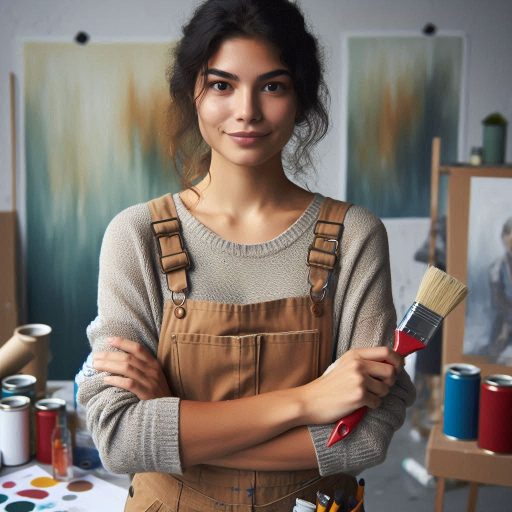Introduction
Safety is paramount in the world of glass art to prevent accidents and injuries.
For new artists, safety tips are crucial to ensure a positive and safe experience.
As beginners, they may not be aware of the potential risks involved in working with glass.
By following safety guidelines, new artists can enjoy their craft without endangering themselves.
It is important to establish good safety practices from the beginning to avoid accidents.
Understanding the risks associated with glass art will help new artists make informed decisions.
Safety tips can prevent burns from hot glass, cuts from sharp edges, and exposure to harmful chemicals.
Proper ventilation is essential to avoid inhaling toxic fumes produced during the glassmaking process.
New artists should wear appropriate protective gear such as gloves, goggles, and aprons.
Training and supervision are also important for new artists to learn proper glass art techniques.
By prioritizing safety, new artists can focus on honing their skills and creating beautiful glass art pieces.
Understand the Tools and Equipment
Essential tools and equipment for glass art
- Glass cutter – used to cut glass into desired shapes
- Glass grinder – for smoothing rough edges of glass pieces
- Glass kiln – for firing glass projects
- Glass pliers – for breaking and shaping glass
- Glass molds – used to create different shapes in glass art
Proper Usage of Tools
To use each tool effectively and safely, it’s important to understand their functions and how to operate them correctly.
Here are some tips on the proper use of essential glass art tools:
- Glass cutter: Hold the cutter firmly and apply even pressure while scoring the glass.
- Glass grinder: Keep the glass piece moving to avoid overheating and cracking.
- Glass kiln: Follow manufacturer’s instructions for temperature and firing time.
- Glass pliers: Use the proper pliers for breaking or shaping glass without damaging it.
- Glass molds: Apply a release agent before pouring glass into the mold for easy removal.
Importance of wearing safety gear
When working with glass, safety should always be a top priority.
Wearing appropriate safety gear can protect you from potential hazards.
Here’s why it’s important to wear safety gear like goggles and gloves:
- Goggles: Protect your eyes from glass shards and dust that can cause injuries.
- Gloves: Prevent cuts and burns while handling sharp glass pieces or working with a kiln.
- Apron: Protect your clothes from glass particles and stains during the glass art process.
- Closed-toe shoes: Avoid injuries from dropped tools or glass pieces by wearing protective footwear.
- Respirator mask: Prevent inhalation of harmful fumes or dust particles while working with glass.
By understanding how to use tools properly and wearing the necessary safety gear, you can enjoy creating beautiful glass art projects while staying safe and protected.
Read: Inspirational Glass Art Design Ideas
Proper Ventilation
Proper ventilation is crucial for glass artists to ensure their safety while working with molten glass.
Importance of working in a well-ventilated area
- Prevents inhalation of harmful fumes and gases
- Reduces the risk of respiratory issues and other health problems
- Improves overall air quality in the workspace
- Enhances the artist’s comfort and productivity
Tips on setting up a proper ventilation system
- Install a ventilation hood above the work area to capture fumes
- Use an exhaust fan to remove contaminated air from the space
- Keep windows and doors open to allow fresh air circulation
- Consider using air purifiers for additional filtration
Dangers of inhaling fumes from melting glass
- Exposure to toxic chemicals can cause respiratory irritation
- Long-term inhalation of fumes may lead to chronic health conditions
- Certain materials used in glassmaking can release harmful gases when heated
- Protective measures are essential to prevent health risks for artists
By prioritizing proper ventilation in their workspace, glass artists can significantly reduce the potential health hazards associated with inhaling fumes while working with molten glass.
Transform Your Career Today
Unlock a personalized career strategy that drives real results. Get tailored advice and a roadmap designed just for you.
Start NowRead: Collaborating with Communities on Mural Projects
Handling Hot Glass
Working with hot glass is an essential part of creating glass art, but it also comes with its own set of risks.
Here are some safety precautions and tips to ensure you stay safe while working with hot glass:
Safety precautions when working with hot glass
- Always wear proper protective gear, such as heat-resistant gloves, long sleeves, and closed-toe shoes.
- Make sure your workspace is well-ventilated to prevent inhaling toxic fumes released by hot glass.
- Avoid wearing loose clothing or accessories that could get caught in the glass or near the heat source.
- Keep a fire extinguisher nearby in case of emergencies and know how to use it properly.
- Never leave hot glass unattended, even for a short period, as it can quickly cool and crack.
Tips on preventing burns and injuries
- Be aware of your surroundings and avoid distractions while handling hot glass to prevent accidents.
- Always use tools specifically designed for working with hot glass to minimize the risk of burns.
- Handle hot glass with care and avoid sudden movements that could cause splashing or spills.
- Keep a first aid kit nearby with burn cream, bandages, and other essentials for treating minor injuries.
- Take regular breaks to rest and cool down to prevent fatigue and reduce the risk of accidents.
Proper techniques for handling molten glass
- Learn proper glassblowing techniques from an experienced artist or instructor before attempting to work with molten glass.
- Always keep molten glass at the recommended temperature to prevent it from solidifying too quickly or becoming too hot to handle.
- Use a reheating furnace to maintain the molten glass’s temperature and keep it in a workable state for shaping and forming.
- Avoid using your bare hands to handle molten glass, always use the appropriate tools and equipment to prevent burns.
- Practice proper glass cutting and shaping techniques to avoid accidents and ensure precision in your glass art creations.
By following these safety precautions, tips, and proper techniques for handling hot glass, you can minimize the risks associated with working with this material and enjoy creating beautiful glass art safely.
Read: Glass Art vs. Traditional Art Forms

Safe Glass Cutting Techniques
When working with glass as a medium, one of the most important skills to master is cutting glass safely.
Here are some tips on how to do so:
Different glass cutting tools
- Glass cutter: A tool specifically designed for scoring glass before breaking it.
- Glass cutting pliers: Used for breaking scored glass along the score line.
- Glass cutting saw: A tool used for cutting thicker pieces of glass that cannot be scored.
Tips on how to safely cut glass without injuring yourself
- Always wear safety goggles to protect your eyes from flying glass particles.
- Use a sturdy work surface to cut glass on, like a cutting mat or a piece of plywood.
- Score the glass deeply and evenly to ensure a clean break when breaking it along the score line.
- Avoid applying too much pressure while cutting glass, as it can cause the glass to shatter unpredictably.
- Keep your fingers away from the cutting line to prevent accidental cuts.
Importance of practicing safe cutting techniques
Practicing safe cutting techniques is crucial for several reasons:
- Prevents injuries: By following proper safety protocols, you can avoid potential accidents and injuries while working with glass.
- Ensures clean cuts: Using safe cutting techniques will result in clean, precise cuts without any jagged edges or uneven breaks.
- Enhances efficiency: By cutting glass safely, you can work more efficiently without having to worry about making mistakes or getting hurt.
By mastering safe glass cutting techniques, you can create beautiful glass art pieces without putting yourself at risk of injury.
Read: Exploring Modern Glass Art Trends
Cleanup and Disposal
When working with glass art, proper cleanup and disposal techniques are essential to ensure safety for yourself and others.
Here are some tips to help you navigate this crucial aspect of glass art creation.
Proper methods for cleaning up glass shards and scraps
- Wear heavy-duty gloves to protect your hands from cuts while picking up glass shards.
- Use a broom and dustpan to sweep up larger glass pieces safely into a sturdy container.
- For tiny glass fragments, use a damp paper towel to carefully pick them up without risking injury.
- Dispose of glass scraps in a designated container labeled for glass waste only.
- Do not mix glass waste with other materials to avoid contaminating the recycling process.
Importance of disposing of glass waste safely
- Improper disposal of glass waste can pose a risk to sanitation workers and the environment.
- Broken glass left in public spaces can injure unsuspecting individuals, including pets and wildlife.
- Follow local regulations for glass disposal to help protect the community and ecosystem.
- Recycle glass whenever possible to reduce waste and promote sustainable practices.
Tips on preventing injuries while cleaning up and disposing of glass materials
- Always wear protective gear, including gloves and safety glasses, when handling glass waste.
- Be cautious when working with sharp objects, such as glass cutters, to minimize the risk of accidents.
- Avoid rushing through cleanup tasks to prevent accidental injuries from handling glass pieces too quickly.
- Store glass waste in a secure location to prevent access by children or pets.
- Regularly inspect your workspace for any stray glass fragments to address potential safety hazards promptly.
By following these cleanup and disposal guidelines, you can create a safer environment for yourself and others while pursuing your passion for glass art.
Proper Storage of Glass Materials
When it comes to working with glass art, proper storage of your glass materials is crucial to ensure safety and avoid accidents that may lead to injuries.
Here are some tips on how to organize and store your glass materials in a secure manner:
Importance of storing glass materials safely
- Prevent accidents: Storing glass materials properly helps avoid breakage and injury.
- Prolong material lifespan: Correct storage methods can prevent damage to your glass materials.
- Maximize workspace: Organized storage allows for more efficient use of your workspace.
- Enhance creativity: A well-organized space can inspire creativity and productivity in your glass art.
Tips on organizing and storing glass materials
- Use shelves or cabinets: Store glass sheets vertically to prevent them from warping or breaking.
- Separate different types of glass: Keep clear, colored, and textured glass separate to avoid confusion.
- Label containers: Clearly label containers for small glass pieces to easily identify what is inside.
- Invest in storage containers: Purchase specialized containers designed for glass materials to ensure safe storage.
- Avoid overcrowding: Leave enough space between stored materials to prevent accidental breakage.
How to safely transport glass materials
Transporting glass materials requires careful handling to prevent accidents and maintain the integrity of the glass.
Here are some guidelines on how to safely transport your glass materials:
- Use protective packaging: Wrap glass materials in bubble wrap or foam to cushion them during transport.
- Secure containers: Place glass materials in sturdy containers with tight-fitting lids to prevent shifting.
- Handle with care: Always carry glass materials with two hands to distribute weight evenly.
- Avoid sharp objects: Keep glass materials away from sharp objects that may scratch or damage the surface.
- Use caution when loading and unloading: Be extra careful when loading and unloading glass materials from vehicles to prevent breakage.
By following these safety tips for storing and transporting glass materials, you can create a safer working environment for yourself and others while enjoying the art of glassmaking.
Emergency Preparedness
Importance of Having a First Aid Kit on Hand
As a glass artist, accidents can happen unexpectedly while working with sharp tools or hot glass.
It is crucial to have a fully stocked first aid kit readily available in case of emergencies.
Transform Your Career Today
Unlock a personalized career strategy that drives real results. Get tailored advice and a roadmap designed just for you.
Start NowA first aid kit should include essentials such as bandages, gauze, antiseptic wipes, adhesive tape, scissors, tweezers, and pain relievers.
Make sure to check the kit regularly and replace any expired items.
Tips on What to Do in Case of an Emergency
In the event of an accident, it is important to stay calm and assess the situation.
If there is a minor cut or burn, clean the wound with soap and water and apply a sterile bandage.
For more serious injuries such as severe cuts or burns, seek medical attention immediately.
Do not attempt to treat major injuries on your own as it could worsen the condition.
Importance of Knowing Emergency Contact Information
It is vital to have a list of emergency contact numbers easily accessible in case of an emergency.
Make sure to include numbers for local emergency services, such as 911, as well as contact information for family or friends.
Having this information readily available can save valuable time in the event of an emergency and ensure that help arrives quickly.
Keep this list in a visible and easily accessible location in your workspace.
Conclusion
New artists in glass art should always prioritize safety in their work.
Safety should always come first in glass artistry to prevent accidents and injuries.
Here’s a recap of the safety tips for new artists:
- Wear appropriate safety gear such as gloves and goggles.
- Work in a well-ventilated area to avoid exposure to harmful fumes.
- Avoid distractions and focus on your work to prevent accidents.
- Handle glass with care to prevent cuts and injuries.
- Clean up your workspace regularly to minimize the risk of accidents.
As you embark on your journey as a glass artist, remember that safety is non-negotiable.
By following these safety tips and prioritizing your well-being, you can create beautiful glass art without putting yourself at risk.
Always remember, safety first!




